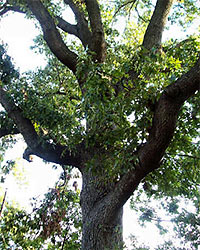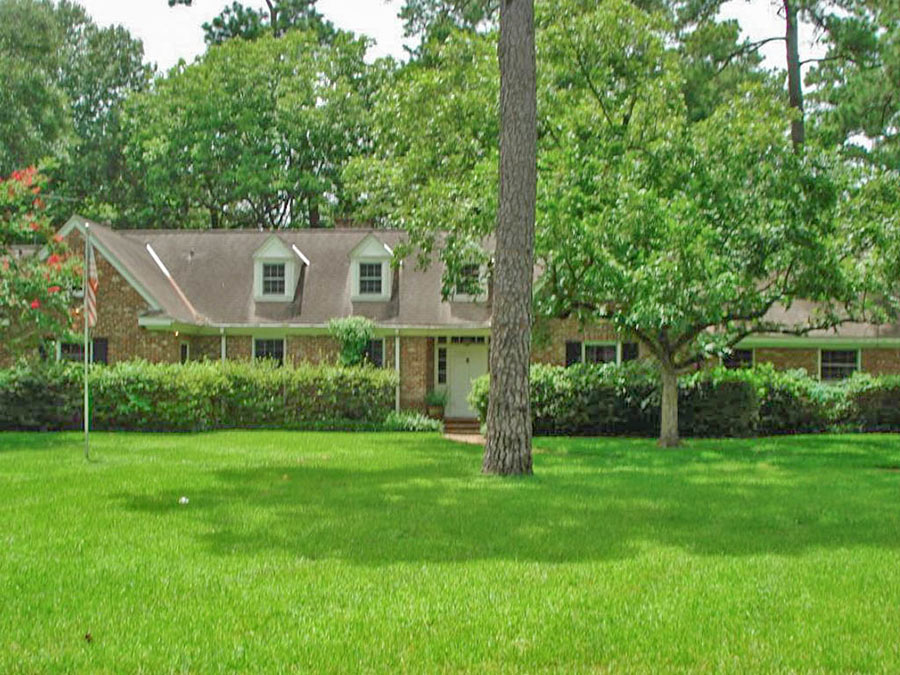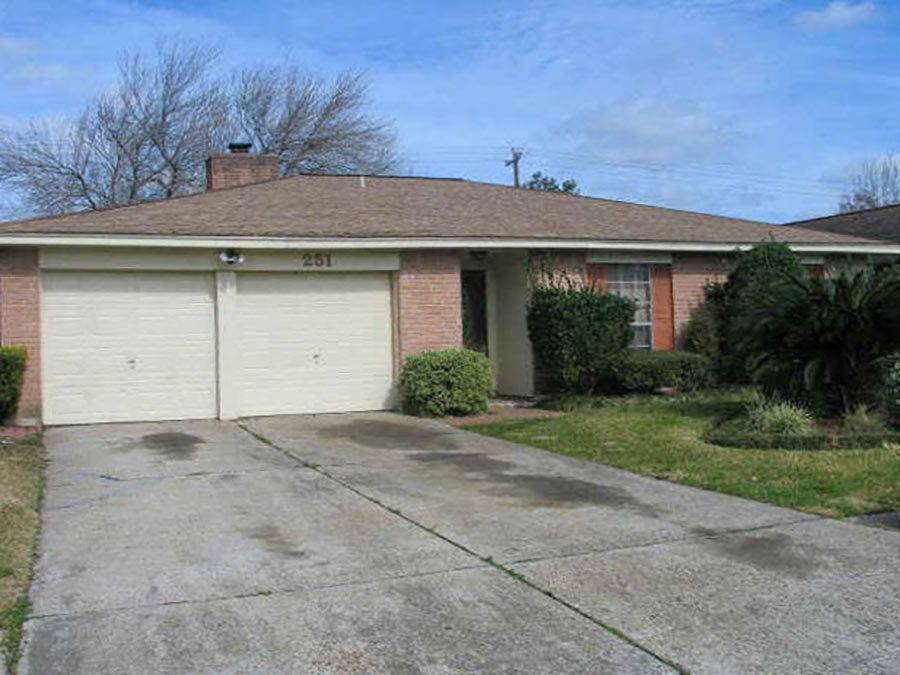MORE OF THE STORY OF THOSE DISAPPEARING OAK FOREST OAKS  “My neighbor lived in what you would consider a ‘tear down.’ For several years she struggled with selling and moving or rebuilding on the lot. A big factor in the decision was finding a builder that would keep the integrity of the lot and not cut down the gem – a 100 year old tree that is 4′ in diameter. She thought that she found the builder that respected the tree and had the same vision while simultaneous[ly] she found her dream home over in Garden Oaks. . . . Shortly after the transition, a family bought the lot and are ready to build . . . I have 2 neighbors including myself that would take this tree. I have till Friday to find an association that would underwrite this project and be interested in saving this tree.” [Kat Alan Madison + Austin; previously on Swamplot] Photo: HAR
“My neighbor lived in what you would consider a ‘tear down.’ For several years she struggled with selling and moving or rebuilding on the lot. A big factor in the decision was finding a builder that would keep the integrity of the lot and not cut down the gem – a 100 year old tree that is 4′ in diameter. She thought that she found the builder that respected the tree and had the same vision while simultaneous[ly] she found her dream home over in Garden Oaks. . . . Shortly after the transition, a family bought the lot and are ready to build . . . I have 2 neighbors including myself that would take this tree. I have till Friday to find an association that would underwrite this project and be interested in saving this tree.” [Kat Alan Madison + Austin; previously on Swamplot] Photo: HAR





I hope you have DEEEEEEEEEEEP pockets. It is not easy to transfer and save old oaks. Most cases I’ve seen and heard where it has been tried the tree ends up dying.
I have a co-worker who lives in Oak Forest. She and many of her neighbors didn’t lose so much as a splinter during Ike largely because trees like this broke up the staight-line winds. Yes, the fallen also played havoc with the power lines, but as she put it, “I’d rather have no power than no roof!”
People here don’t realize that oaks are much more hurricane resistant and desirable than pines in coastal areas. In Katrina, the oaks lost small limbs, but very few went down. Pines snap off 1/2 to 2/3 of the way up and the falling section slices right through the roof, often breaking the ceiling.
Since the water did so much damage in New Orleans proper, the tremendous damage caused by pine trees didn’t get much publicity. North of New Orleans where it’s almost all pines and many nice new houses, almost everyone I knew had pine trees that had crashed through their roofs. One friend had 6 on his house, including one that took out the gas line. My sister-in-law had two on her house and wound up spendng months in a trailer while repairs were made to her very nice house in very nice neighborhood.
The other point I would like to make is why build a big house when there are McMansions for sale all over Houston? Some people don’t get that it’s the end of an era.
If this family really likes treeless lots and giant mansions with pools, they should go live in a deforested recent suburban development somewhere. Preferably as far as possible from actual nice neighborhoods that have banded together to keep their trees healthy. Gah.
Two Oaks this size came down within a 5 block radius of my home during Ike and both crushed the original homes they fell on both of which were occupied at the time. In the one case I am most familiar with the homeowners were about 5 feet from where the tree came in. I agree that it would be shame to lose this tree but its a bit of a stretch to suggest that trees don’t have the ability to destroy homes during hurricanes just as easily as to protect them.
I echo Jimbo’s comments.
In Cottage Grove, a single oak on the scale of the picture above twisted out the ground and took town all power, cable, and telephone lines for much of Cottage Grove. I was lucky to be one block away to not get affected. I had power within 2.5 days. Must of the rest of the neighborhood took over 2 weeks to get power.
Don’t get me wrong, I love having the trees in my neighborhood and would resist any effort to remove them. However their prescence undoubtedly caused more damage than it prevented during Ike. The number of still empty lots near me is clear testament to that.
I don’t know about 100 years old. Maybe 70. The house was built in 1950. Maybe someone out there believes that trees naturally grow in perfectly street-shaped patterns in the wild, but I’m prepared to assume that it was probably no older than ten years when it was replanted on site. Seventy is plenty old, of course, but 100 sounds magical and mythical, not to mention manipulative. Is there any evidence that the tree was already on site when the house was built? If so, then I’ll gladly retract this comment. Otherwise, I think it would be far more practical and profitable to plant a couple of 20- or 30-year-old oaks [which is not cheap to begin with — good four figures easily] and wait a decade or two for them to mature to the level of shadiness so desired by residential Houstonians. (FWIW, I replaced a 40- or 50-year-old pine with a 15-year-old live oak on my own lot a couple of years back).
Having lived in Oak Forest for 17 years, I personally planted many of the trees on the esplanades in various areas of the subdivision. Some of the burr oaks look fantastic by now. An oak can grow pretty big over the course of 50-70 years after planting. When building our new house, I planted a 100 gallon live oak in the front yard instead of the city required 4″ caliber tree the builder would have put in. It’s doing great, so are the several 10 gal live oaks I planted in my yards at the lake.
The people that are building most likely appreciate the overall look of Oak Forest because of all of the mature neighborhood trees, and close-in proximity, not necessarily the fact that there were mature trees on the lot they were to build on. Someone drawn to building in a subdivision like Oak Forest, most likely would not see any allure in a recently established far out subdivision.
Several people in my area got hurricane panic and had large trees cut down. They weren’t very happy last summer with the effect the heat wave had on their unshaded houses and lawns.
And while we are protecting ourselves from falling trees, did you know that one of the most comon reason adults end up in the ER is …they fell? I suggest everyone lie down immediatley and stay there.
But seriously – this is what the close-in neighborhoods are becoming – places where all the trees are actually owned by the city because they are on easements.
When people buy a lot, scrape the home, the trees, and place holiday inns in the midst of modest homes, it’s obvious there is a disconnect between the wealthy and the middle class. On street after street in the Heights area, I see trash bags and trash cans in front of $600K+ homes all week. I see Hummers parked across the sidewalks. I see ditches not draining around high density new construction. The Clampetts have invaded.